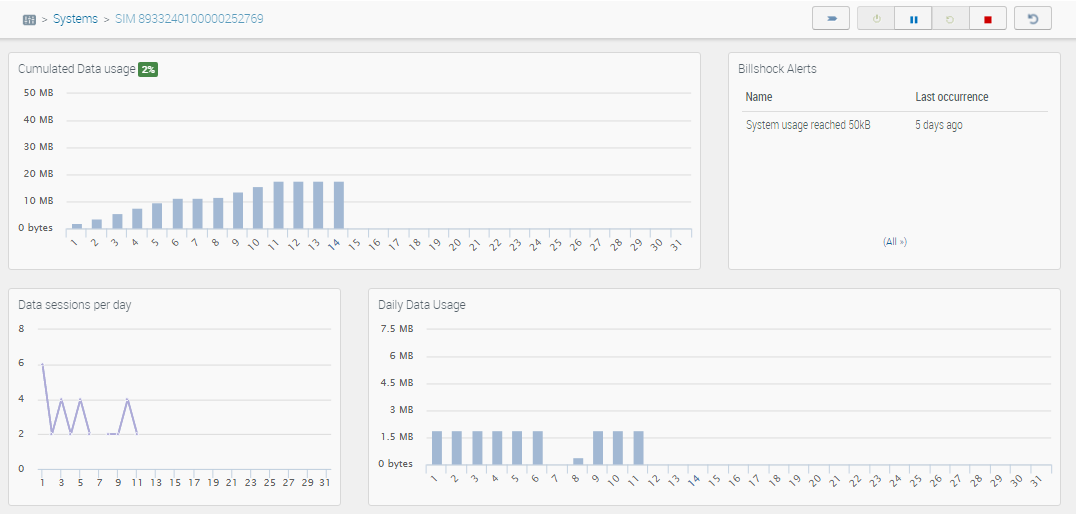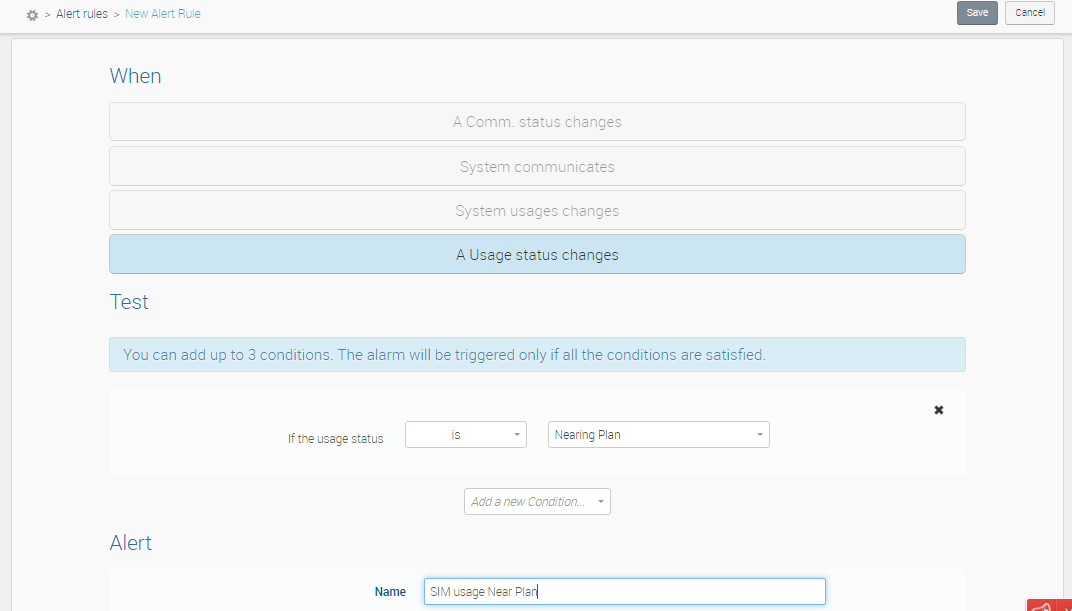Getting Started with AirLink Routers
This page provides a high-level quick start guide to getting started with your ALMS account.
Step 1: Create an Account
ALMS accounts, as part of your AirLink Complete service, provide the best way to manage AirLink routers. Your ALMS account can also support Sierra Wireless Connectivity, providing access to our Smart Connectivity which provides global coverage with access to 600 networks in more than 190 countries: all with one SIM. For more information on Sierra Wireless Connectivity, please click here .
Click here to create a new ALMS account, or see How to create an ALMS account.
Most ALMS users will create an account that has “Pre-paid” offers that provide access to our standard AirLink services – AirLink Complete and AirLink Premium. When an account is set-up with Pre-paid offers, it is expected that you submit renewals through your Sierra Wireless Partner. Please process your renewals prior to the expiration of your initial service term to avoid devices being suspended.
Optionally, customers may choose to set-up their accounts with “Direct Billing offers”. When creating the account, you have the option to sign a services contract (via DocuSign) and provide a payment method (credit card in the United States; Single Euro Payments Area (SEPA) account in Europe*) for billing. In this case, you are invoiced every month for the services that you use.
Your account will be created with a set of Default Offers that provide the standard services needed by most AirLink customers. If you need other plans beyond the default plans (AirLink Connectivity, for example), contact our technical support team from within your account.
Sierra Wireless provides data residency in the following regions. For customers outside these regions, please create an account in the region that best aligns for you.
North America (US and Mexico): signup link
Canada: signup link
Australia: signup link
Europe (all EU member states): signup link
For more information, see How to create an ALMS account and ALMS Regions.
While ALMS accounts that support connectivity can be created in the regions listed above, customers that wish to activate a Ready to Connect gateway on a connectivity offer must have their account created on the EU server. Sierra Wireless Ready-to-Connect connectivity is only supported on this instance. Sierra Wireless Customer Support can assist with the account creation process for scenarios where the server instance and your organizations geography do not align.
For more information on Ready to Connect routers, please see the section below.
Supported Devices
AirLink Management Service (ALMS) supports both current generation and legacy AirLink gateways and routers. The information you require for registering your devices into ALMS depends on the device’s embedded operating system:
AirLink OS
For routers running AirLink OS, such as AirLink XR90, XR80, XR60 and RX55, you will need the device’s Serial Number and Registration Code. This information is printed and bar-coded on the device label.
ALEOS
For ALEOS-based devices you will need the device’s Serial Number and IMEI (in the case of the ES450, GX450, MP70, RV50, RV50X, RV55, LX40 and LX60). This information is printed and bar-coded on the device label.
For all shipments, your Sierra Wireless Partner should also be able to provide a spreadsheet with the required information to make bulk registration easier.
For more information about how to configure your router to use ALMS, please refer to the dedicated router configuration page.
Principles of Device Communications
The basic premise of the interaction between the router...
… and ALMS is that the AirLink device initiates communications and the platform responds back to the device with any operations that are currently in the queue. This is referred to as device-initiated communications and is based on the Heartbeat timer set by the user. Operations that may be in the queue in ALMS include things like a request for a Default Status Report (which asks the device to send a standard set of approximately 20 common status parameters), apply a new configuration template or update firmware.
The device communication approach varies depending on the embedded software on the device.
- ALEOS devices communicate with ALMS on a scheduled basis. In its default configuration, an ALEOS device will communicate once a day (1,440 minutes).
- AirLink OS devices communicate in a more real-time fashion, sending data to ALMS as the data on the router changes. Typically, the device will update ALMS in real-time – at most, within 1-2 minutes. As a result, the Heartbeat and Default Status report settings in Configure Communication are used to ensure a “worst case” communication frequency for AirLink OS devices.
This timer can easily be set to the time interval of your choice from within ALMS. Alternatively, it can also be set in the embedded software UI, but this will not set the other related timer functions (switch the communication status to warning/error in case of missing heartbeat) in ALMS. We recommend using the configuration setup in ALMS.
Public vs. Private Cellular Network Data Accounts
ALMS is a cloud-hosted service and...
… requires the ALMS communications sent by your AirLink router to have access to the Internet.
If you have restricted Internet or private network data accounts, there are a variety of options to allow ALMS to fully function. Discuss this with your Sierra Wireless Partner to find the best solution for you. For more information, see How to configure private networks for proper device operation .
Step 2: Register and Activate Service on Your Routers
Every AirLink router includes the first year of service on AirLink Complete or AirLink Premium (depending on router model). To activate this included service, your router needs to be registered and activated in ALMS. There are many benefits to registering your routers:
- You activate your included year of service, providing access to ALMS and Sierra Wireless Customer Support
- Claim your device and ensure it is assigned to your company
- Gain visibility into the expiration dates for your Support and Warranty services
To leverage these benefits, the devices need to be registered and activated. The activation process has been integrated with the router registration process, allowing you to register your router and activate it on the right connectivity and/or device management plan for your business.
To register your devices:
- Log into your ALMS account using the credentials sent to you during the account creation process.
- From the Start page dashboard, click the Register widget.
A number of default plans are available in your ALMS account. These may include:
- AirLink Basic
- AirLink Complete
- AirLink Complete (XR80)
- AirLink Premium
- AirLink Connectivity (EU only)
Other offers may be included in your account.
For full details on the registration process, refer to the Register documentation .
To take advantage of AirLink Complete, please register your device within 60 days of purchase. For more information, see the AirLink Complete page.
Enter the Router Serial Number
When you enter the serial number, the Registration page detects your device type and adds the appropriate fields for you to complete.
- For ALEOS devices, the IMEI/ESN field appears.
- For devices running AirLink OS, the Registration Code field appears.
- You can optionally add a name to more easily identify the device in ALMS.
For full details on the registration process, refer to the Register documentation .
Bulk Device Registration
You can also register multiple routers in a single operation by importing a CSV file. The template for this file is downloaded from the Register window. First click Import a list and then click Download template. See How to register a list of systems?.
Note that you can only import the selected type of AirLink router with this action. In this example it is an XR80. If you have other router types, they will have to be registered separately.
Initial Configuration (Pre-configure system)
To simplify your deployment, you can pre-define the configuration you want ALMS to apply when the router connects the first time: Firmware version, Configuration template, Communication intervals with ALMS and scheduled reports. See How to register systems with an initial configuration for more information.
Activate Routers
Your AirLink routers and routers can be activated on the AirLink Complete or AirLink Premium plans (depending on device eligibility).
The activation operation of a Ready-to-Connect gateway in ALMS only completes once the internal SIM has attached to the network and been successfully configured. It is normal to see the activation operation stay “In Progress” until the routers are powered on (see the following steps).
Step 3: Monitor
Once registered and activated, switch on your AirLink router and it will communicate with ALMS. During the first communication, ALMS synchronizes all router parameters and changes the system state to Deployed. The router may reboot one or more times during this process. Your router is now ready to be managed. For your Ready-to-Connect router, you can also track airtime usage of your eSIMs.

The Monitor > Systems page is the primary page for understanding the state of your deployment.
It provides access to all routers along with their status, communication history, configuration and management. This page is also customizable to present the information that is most important to you.
Step 4: Manage Your Fleet
Congratulations! Your first device is connected to ALMS, and you can do both device and connectivity management from a single platform. You can take a look at the management features at your disposal: AirLink Management Services Features.
ALMS Dashboards
The default Dashboard on an ALMS account provides widgets that help with managing both your devices and your connectivity. Widgets include:
- Device state
- Communication status
- Map-based view of device location
- Fleet invoiced data usage
- Signal streng
- …and many others!
The Dashboard is highly configurable, and you can configure it to show the information that is important to you. See the Dashboard page for more details on the full capabilities. The Monitor > Systems page is the primary page for understanding the state of your deployment.
It provides access to all routers along with their status, communication history, configuration and management. This page is also customizable to present the information that is most important to you.
Communication Frequency
If you find that your device is not communicating with ALMS as frequently as required, you should run a Configure Communications operation.
- Click the Configure Communications action button.
- The communications timer window will open and you can set the Heartbeat and Status Report timers as desired. The timers cannot be set for less than 15 minutes.
When selecting more than one router when setting the Configure Communication parameters, all the values will be set to “off”. It is important that you re-set all values, or they will be disabled.
Visualize Device Performance and Airtime Consumption
Drill down to an individual gateway to show:
- Combined system information (Routers and SIMs)
- Month to date cumulated usage graph (Connectivity)
- Consumption status versus the plan (Connectivity)
- Daily consumption graph (Connectivity)
- Daily session count (Connectivity)
- Location information (if available) (Routers)
Set up Alerts
ALMS provides a powerful, rule-based alert engine that can be used to create customized alerts on all aspects on the platform. There are a series of alert rule templates that can be used, or complete customization is possible. Standard templates include:
- Be alerted if devices are not communicating as expected.
- Avoid bill shock by setting up alerts when airtime consumption plan thresholds are being reached.
From your ALMS account, create your own rule by clicking on the Configure > Alert rules menu
Facing an issue in any of the steps?
Please check our FAQ section , and use the search function above to find relevant information, or contact our technical support team from your account: https://eu.airvantage.net/accounts/
Ready to Connect Routers
Supported Devices
An ALMS account provides the greatest value when combined with...
… one of our Ready-to-Connect AirLink routers that include the Sierra Wireless eSIM – the AirLink LX40, LX60 and RV55 (Cat 4 version). These Ready-to-Connect routers include a module that embeds a Sierra Wireless Smart SIM, soldered inside the radio module. Use of this eSIM is optional: all Ready-to-Connect routers can also accommodate an external SIM from any existing carrier.
This guide assumes that you wish to activate your router, including the eSIM, for the full Ready-to-Connect experience. The full Ready-to-Connect experience requires ALEOS 4.14 or later.
For devices running a version of ALEOS prior to 4.14, the router must be manually configured to enable the eSIM. Please refer to this How-to-Article.
Gateway Behavior Before Activation
If you power a Ready-to-Connect router before you activate it on ALMS, the following behavior is expected:
- The router may report a successful attachment to the network.
- No service will be available (e.g. you will not be able to establish a connection that will transfer data).
You are required to register and activate the router in ALMS shortly before its first power-up in order to ensure service availability.
Activate Ready-to-Connect Routers
To take advantage of the ease of use of a Ready-to-Connect router, select one of the AirLink Connectivity plans. This will activate the eSIM to provide connectivity and register the device for AirLink Complete, giving you full access to all the features of ALMS and access to the Sierra Wireless Customer Support team.
Activation operations (including pre-configuration operations) will expire after 1 year and end in a failure if the routers have not been powered on. In this case, activation will have to be retried later, preferably with the router powered on.
Power up the Router
First Start-up
Upon first start-up of a Ready-to-Connect router that has been activated in ALMS, the eSIM must receive over-the-air configuration information and perform a network scan before becoming fully functional.
The approximate duration of this one-time process is 15 minutes. During this time, we request that you follow these guidelines:
- No data, SMS or voice communications should be attempted
- Router reboots should be avoided (or the process will have to start over)
- A loss of network attachment, lasting for a few seconds, may be noticed at the end of the process
The signal that the eSIM and the router is fully ready for use is when the Activation operation in ALMS ends in a success.
Subsequent Start-ups
On subsequent start-ups of the router, network attachment should take around 15 seconds.
 Searching...
Searching...











